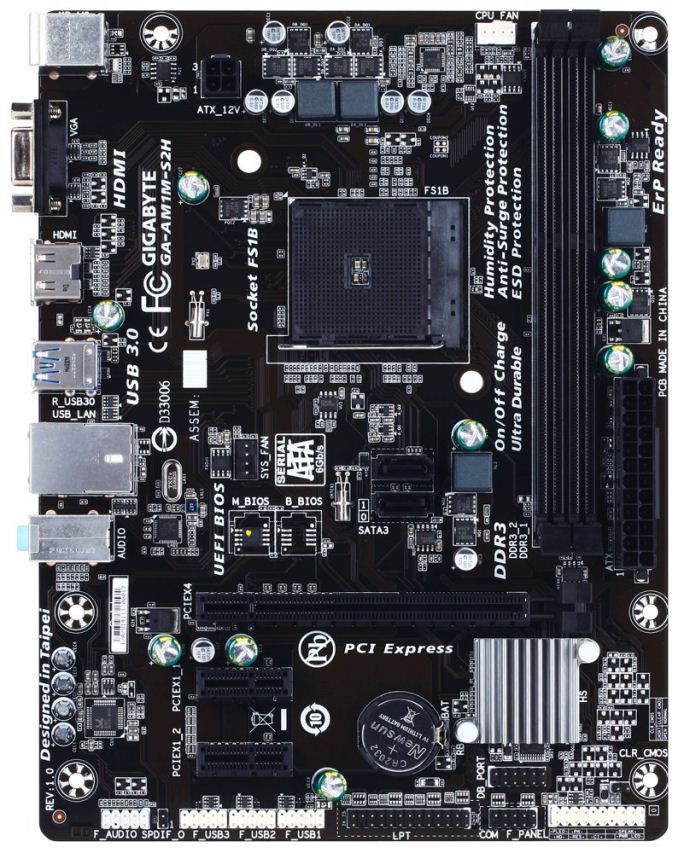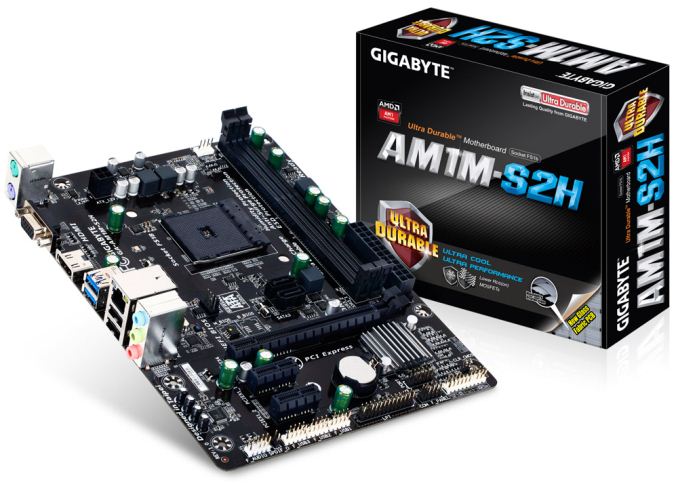The AM1 Kabini Motherboard Preview: Analyzing the Hardware
by Ian Cutress on April 19, 2014 2:00 PM ESTGIGABYTE AM1M-S2H
The motherboard AMD decided to ship with its Kabini review packs was the GIGABYTE AM1M-S2H. By being at the cheaper end of the spectrum, AMD was hoping to show just how cheap a quad core Jaguar derived system could be with one of the major motherboard manufacturers.
The GIGABYTE AM1M-S2H does the motherboard design a little more traditionally than the previous Biostar, in the sense that the DRAM slots are in the regular orientation and the 4-pin CPU power connector is also in a place beneficial for cable management:
For a larger motherboard it does seem relatively empty, however due to the low cost nature GIGABYTE has restricted the extras above the standard package. Aside from what Kabini provides GIGABYTE has equipped the AM1M-S2H with two BIOS chips for their DualBIOS topology. We get a regular Ethernet gigabit controller as well, along with a Realtek ALC887 audio codec rather than the ultra-low-cost ALC662.
Both fan headers on the motherboard are 4-pin, and because we actually have this motherboard in house to test, we can confirm that the BIOS and software are up to date with a modern platform. GIGABYTE states compatibility with 16GB DDR3 DRAM modules which Biostar does not, so we are just waiting for them to actually come to market.
The rear panel is pretty bleak, although we get a HDMI port supporting 4K UHD at 30 Hz. Given the power of a Kabini APU, gaming at that resolution might be best avoided.
| GIGABYTE AM1M-S2H | |
| Price | Link |
| Size | Micro-ATX |
| CPU Interface | FS1b |
| Chipset | Kabini |
| Memory Slots |
Two DDR3 DRAM slots supporting 32GB Single Channel, 1333/1600 MHz |
| Video Outputs |
VGA (1920x1200) HDMI (4096x2160) |
| Onboard LAN | Realtek (10/100/1000) |
| Onboard Audio | Realtek ALC887 |
| Expansion Slots |
1 x PCIe 2.0 x16 (x4) 2 x PCIe 2.0 x1 |
| Onboard SATA/RAID | 2 x SATA 6 Gbps |
| USB 3.0 | 2 x USB 3.0 (Chipset) [back panel] |
| Onboard |
2 x SATA 6 Gbps 2 x USB 2.0 Headers 2 x Fan Headers Front Audio Header Front Panel Header COM Header LPT Header S/PDIF Output Header |
| Power Connectors |
1 x 24-pin ATX 1 x 4-pin CPU |
| Fan Headers |
1 x CPU (4-pin) 1 x SYS (4-pin) |
| IO Panel |
1 x PS/2 Keyboard Port 1 x PS/2 Mouse Port VGA HDMI 2 x USB 3.0 2 x USB 2.0 1 x Ethernet (1 Gbps) Audio Jacks (ALC887) |
| Product Page | Link |
Compared to the $33 AM1ML, the GIGABYTE offers a lot for $2 more – DualBIOS, a full microATX size, gigabit Ethernet, a better audio codec, both fan headers are 4-pins and a more traditional orientation for DRAM and cable management.
We should have a full review of this motherboard in due course.














64 Comments
View All Comments
JFish222 - Monday, April 21, 2014 - link
I agree, its disappointing that there is no ECC. (At least not listed.)I was really looking forward to using one of these for a low cost FreeNAS box.
Ian, Anand and company. Please encourage ECC bios support/validation! If any of the manufacturers support it (not always obvious when they do) please point it out.
For those that don't understand the importance, ZFS has numerous benefits but its greatest weakness is the ability to corrupt the entire data pool due to a flipped bit or 2 in RAM.
For more info - http://forums.freenas.org/index.php?threads/ecc-vs...
Chicken76 - Monday, April 21, 2014 - link
Indeed, Anandtech has the ear of motherboard manufacturers. They might respond positively if such suggestions are properly argumented. There's not only the enthusiast home user that these might be useful to, there's also the small businesses sector, where cost is a deciding factor. Add ECC support and a bit of validation for production use, and a lot of the cost-conscientious businesses will refresh their storage boxes and low workload machines using Kabini, instead of the Pentiums and Celerons they use now.rogueninja - Sunday, April 20, 2014 - link
Only bad friends recommend AMD.meacupla - Sunday, April 20, 2014 - link
Currently, AMD's most attractive CPU parts are the $60 A6-6400k and $120 FX-6300.Pentium and i3 have more single thread computing power, but looking at the entire package, AMD has some advantages at those price points.
Like a cheap 8 port SATA mobo, you can't have that with cheap LGA1150 boards.
or having 6 physical cores.
Antronman - Monday, April 21, 2014 - link
Except that when you're on a low budget, AMD is the only thing you should be recommending.Ortanon - Tuesday, April 22, 2014 - link
Intel usually wins low-budget too, haha. If you're talking "best gaming performance at the absolute bottom," yes, AMD wins. But who wants to game down there? As soon as you try to add any performance to your build whatsoever, it turns into an Intel solution with a PCIe GPU. It's possible that this would be different if all software was highly-threaded, but it just doesn't work out that way.AlB80 - Sunday, April 20, 2014 - link
Gigabyte's mobo has heatsink. What behind it? SuperIO?DuckieHo - Monday, April 21, 2014 - link
Biostar's mITX-Plus..... isn't that just AMD's DTX form factor?JBVertexx - Monday, April 21, 2014 - link
Stumbled across this - PC build in the motherboard box:https://www.youtube.com/watch?v=xngzjrKg3zI
WeatherDave - Monday, April 21, 2014 - link
"COM port, LPT port and a TPM port on the same PCB"We have about 50 machines here. Mostly for embedded testing, such as stepper motors, and old equipment that ONLY connects via Serial Port. USB converters are both unreliable and prone to failure, so we like having the COM ports on board. Besides, Windows 98/2000 and XP much prefer them over a converter. Now, we don't have much use for the LPT, but TPM and a cheap SSD certainly keeps IT Security off our backs.